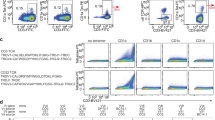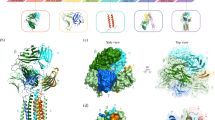Abstract
The binding of a T-cell antigen receptor (TCR) to peptide antigen presented by major histocompatibility antigens (pMHC) on antigen-presenting cells (APCs) is a central event in adaptive immune responses1,2. The mechanism by which TCR–pMHC ligation initiates signalling, a process termed TCR triggering, remains controversial3,4,5. It has been proposed6,7,8 that TCR triggering is promoted by segregation at the T cell–APC interface of cell-surface molecules with small ectodomains (such as TCR–pMHC and accessory receptors) from molecules with large ectodomains (such as the receptor protein tyrosine phosphatases CD45 and CD148). Here we show that increasing the dimensions of the TCR–pMHC interaction by elongating the pMHC ectodomain greatly reduces TCR triggering without affecting TCR–pMHC ligation. A similar dependence on receptor–ligand complex dimensions was observed with artificial TCR–ligand systems that span the same dimensions as the TCR–pMHC complex. Interfaces between T cells and APCs expressing elongated pMHC showed an increased intermembrane separation distance and less depletion of CD45. These results show the importance of the small size of the TCR–pMHC complex and support a role for size-based segregation of cell-surface molecules in TCR triggering.
This is a preview of subscription content, access via your institution
Access options
Subscribe to this journal
Receive 51 print issues and online access
$199.00 per year
only $3.90 per issue
Buy this article
- Purchase on Springer Link
- Instant access to full article PDF
Prices may be subject to local taxes which are calculated during checkout




Similar content being viewed by others
References
van der Merwe, P. A. & Davis, S. J. Molecular interactions mediating T cell antigen recognition. Annu. Rev. Immunol. 21, 659–684 (2003)
Davis, M. M. et al. Dynamics of cell surface molecules during T cell recognition. Annu. Rev. Biochem. 72, 717–742 (2003)
van der Merwe, P. The TCR triggering puzzle. Immunity 14, 665–668 (2001)
Davis, M. M. A new trigger for T cells. Cell 110, 285–287 (2002)
Trautmann, A. & Randriamampita, C. Initiation of TCR signalling revisited. Trends Immunol. 24, 425–428 (2003)
Davis, S. J. & van der Merwe, P. A. The structure and ligand interactions of CD2: implications for T-cell function. Immunol. Today 17, 177–187 (1996)
van der Merwe, P. A., Davis, S. J., Shaw, A. S. & Dustin, M. L. Cytoskeletal polarization and redistribution of cell surface molecules during T cell antigen recognition. Semin. Immunol. 12, 5–21 (2000)
Shaw, A. S. & Dustin, M. L. Making the T cell receptor go the distance: a topological view of T cell activation. Immunity 6, 361–369 (1997)
Weiss, A. & Samelson, L. E. in Fundamental Immunology (ed. Paul, W. E.) 321–364 (Lippincott Williams & Wilkins, Philadelphia, 2003)
Springer, T. A. Adhesion receptors of the immune system. Nature 346, 425–434 (1990)
Barclay, A. N. et al. The Leucocyte Antigen Factsbook (Academic, London, 1997)
Yu, Y. Y., Netuschil, N., Lybarger, L., Connolly, J. M. & Hansen, T. H. Cutting edge: single-chain trimers of MHC class I molecules form stable structures that potently stimulate antigen-specific T cells and B cells. J. Immunol. 168, 3145–3149 (2002)
Cresswell, P., Bangia, N., Dick, T. & Diedrich, G. The nature of the MHC class I peptide loading complex. Immunol. Rev. 172, 21–28 (1999)
Porgador, A., Yewdell, J. W., Deng, Y., Bennink, J. R. & Germain, R. N. Localization, quantitation, and in situ detection of specific peptide-MHC class I complexes using a monoclonal antibody. Immunity 6, 715–726 (1997)
Dillon, S. R., Jameson, S. C. & Fink, P. J. V beta 5 + T cell receptors skew toward OVA + H-2Kb recognition. J. Immunol. 152, 1790–1801 (1994)
Kersh, E. N., Shaw, A. S. & Allen, P. M. Fidelity of T cell activation through multistep T cell receptor ζ phosphorylation. Science 281, 572–575 (1998)
Garboczi, D. N. et al. Structure of the complex between human T-cell receptor, viral peptide and HLA-A2. Nature 384, 134–141 (1996)
Garcia, K. C. et al. Structural basis of plasticity in T cell receptor recognition of a self peptide-MHC antigen. Science 279, 1166–1172 (1998)
Wild, M. K. et al. Dependence of T cell antigen recognition on the dimensions of an accessory receptor-ligand complex. J. Exp. Med. 190, 31–41 (1999)
Chan, P.-Y. & Springer, T. S. Effect of lengthening lymphocyte function-associated antigen 3 on adhesion to CD2. Mol. Biol. Cell 3, 157–166 (1992)
Irles, C. et al. CD45 ectodomain controls interaction with GEMs and Lck activity for optimal TCR signalling. Nature Immunol. 4, 189–197 (2003)
Lin, J. & Weiss, A. The tyrosine phosphatase CD148 is excluded from the immunologic synapse and down-regulates prolonged T cell signalling. J. Cell Biol. 162, 673–682 (2003)
Dustin, M. L. et al. A novel adaptor protein orchestrates receptor patterning and cytoskeletal polarity in T-cell contacts. Cell 94, 667–677 (1998)
Davis, D. M. et al. The human natural killer cell immune synapse. Proc. Natl Acad. Sci. USA 96, 15062–15067 (1999)
Coombs, D., Dembo, M., Wofsy, C. & Goldstein, B. Equilibrium thermodynamics of cell-cell adhesion mediated by multiple ligand-receptor pairs. Biophys. J. 86, 1408–1423 (2004)
Gil, D., Schamel, W. W., Montoya, M., Sanchez-Madrid, F. & Alarcon, B. Recruitment of Nck by CD3 epsilon reveals a ligand-induced conformational change essential for T cell receptor signalling and synapse formation. Cell 109, 901–912 (2002)
Krogsgaard, M. et al. Agonist/endogenous peptide–MHC heterodimers drive T cell activation and sensitivity. Nature 434, 238–243 (2005)
Davis, S. J. et al. The nature of molecular recognition by T cells. Nature Immunol. 4, 217–224 (2003)
Greenwald, R. J., Freeman, G. J. & Sharpe, A. H. The B7 family revisited. Annu. Rev. Immunol. 23, 515–548 (2005)
Lanier, L. L. NK cell recognition. Annu. Rev. Immunol. 23, 225–274 (2005)
Acknowledgements
We thank P. Bowness for providing TCRζ template, R. Germain for the gift of antibody 25-D1.16, T. Elliott for T18 antiserum, N. Shastri for permission to use the B3Z hybridoma, C. Reis e Sousa for providing the B3Z hybridoma, M. Merkenschlager for spleens from OT-1 mice, N. Rust for assistance with cell sorting and M. Shaw for assistance with EM imaging. We thank N. Barclay, S. Davis and members of the van der Merwe laboratory for valuable discussion and advice. This work was supported by the Medical Research Council (P.A.v.d.M., D.W. and M.H.B.) and the Wellcome Trust (K.C. and K.G.).
Author information
Authors and Affiliations
Corresponding authors
Ethics declarations
Competing interests
Reprints and permissions information is available at npg.nature.com/reprintsandpermissions. The authors declare no competing financial interests.
Supplementary information
Supplementary Methods
Full details of experimental methods. (PDF 106 kb)
Supplementary Figure S1
Comparison of stimulation efficiency of SCT and SCD with exogenously added OVA peptide (pOVA-SCD). (PDF 56 kb)
Supplementary Figure S2
Expression of high levels of SCT /elongated SCTs and stimulation of OT1 CD8+ T-cells. (PDF 77 kb)
Supplementary Figure S3
Activation of B3Z T-hybridoma by CHO APCs expressing low levels of SCTs. (PDF 70 kb)
Supplementary Figure S4
Effect of elongation of the SCT ectodomain on TCR/SCT engagement. (PDF 113 kb)
Supplementary Figure S5
Distribution of CD45 at the B3Z/SCT-expressing APC interface. (PDF 58 kb)
Supplementary Figure S6
Characterization of artificial TCR triggering systems and their interaction with native and extended ligands. (PDF 68 kb)
Rights and permissions
About this article
Cite this article
Choudhuri, K., Wiseman, D., Brown, M. et al. T-cell receptor triggering is critically dependent on the dimensions of its peptide-MHC ligand. Nature 436, 578–582 (2005). https://doi.org/10.1038/nature03843
Received:
Accepted:
Issue Date:
DOI: https://doi.org/10.1038/nature03843
This article is cited by
-
Circulating tumor cells shielded with extracellular vesicle-derived CD45 evade T cell attack to enable metastasis
Signal Transduction and Targeted Therapy (2024)
-
Membrane-anchored DNA nanojunctions enable closer antigen-presenting cell–T-cell contact in elevated T-cell receptor triggering
Nature Nanotechnology (2023)
-
Using CombiCells, a platform for titration and combinatorial display of cell surface ligands, to study T-cell antigen sensitivity modulation by accessory receptors
The EMBO Journal (2023)
-
Precise regulation of intermembrane spacing with DNA nanojunctions for enhanced T-cell receptor triggering
Science China Chemistry (2023)
-
The interplay between membrane topology and mechanical forces in regulating T cell receptor activity
Communications Biology (2022)
Comments
By submitting a comment you agree to abide by our Terms and Community Guidelines. If you find something abusive or that does not comply with our terms or guidelines please flag it as inappropriate.



